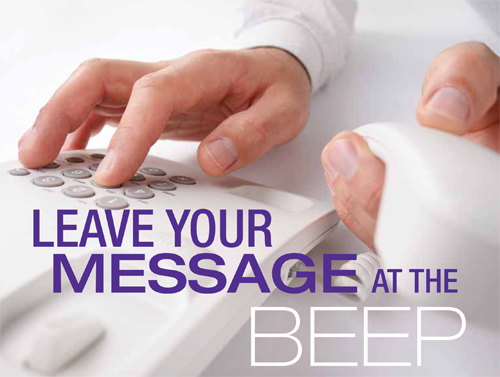Leave your message at the beep

Five ways to succeed at telephone prospecting
By Troy Harrison
To paraphrase Mark Twain, “The rumors of telephone prospecting’s demise are greatly exaggerated.” There’s a reason for that. One of the most marketable things any sales trainer or author can do is tell salespeople, “You don’t have to prospect.” Today’s plethora of social networking tools have fed this fire, telling salespeople that if they only Tweet enough, customers will beat a path to their door. There’s only one problem – it doesn’t work. The average B2B salesperson might pick up one or two new pieces of business here and there, but if growth is needed, a dedicated prospecting effort is the only answer. Still, there are obstacles.
- How can you make prospecting a good use of your sales reps’ time?
- How can you manage a process that will ensure the results happen?
- How do you motivate your salespeople to prospect?
- How can your salespeople effectively win appointments?
The answer to all of these questions is, “A quality data-driven teleprospecting program.” A data-driven teleprospecting process is far different from what most salespeople do. Most prospecting processes fail because they are based in an obsolete approach (door-to-door prospecting), or because they have inadequate resources or metrics (most telephone prospecting). Without the right process, tools and metrics, your salespeople won’t get the appointments they need in order to grow their territories.
The good news is that YOU can put the right tools, metrics and resources in place to get appointments with new customers efficiently and effectively – whether “YOU” are a salesperson, a sales manager, or a business owner. All you need to do is implement these five keys:
1) Have a good database. For some reason, data acquisition is the most intimidating part of teleprospecting to many people. It shouldn’t be. You can acquire a calling list that costs (from Dun and Bradstreet, Hoover’s, or InfoUSA) or even for free (from ReferenceUSA, an offshoot of InfoUSA that’s available through most public libraries). Start by describing your target customer. Use Geography, Business Type, and Business Size as your primary selectors, and you can branch out from there. Then either buy a database from one of the three companies mentioned above, or get a library card and PIN and access ReferenceUSA from a nearby library. Either way, without a database with a quantity of contacts (500 to 1,000 per territory minimum), you won’t be able to succeed.
A “quality database” includes, at minimum, the following fields for each company record: Contact name and title, company name, phone number, address, website, type of business and business size (either in employees or revenue). If you have this information, you have everything you need to know in order to make the call – extensive pre-call research is unnecessary and a time waster. Research AFTER getting the appointment.
2) Import the database into a good CRM system. CRM, of course, stands for Customer Relationship Management, and it can be fairly inexpensive and installable on one computer, or it can be an enterprise solution. Are you a salesperson and your company doesn’t have CRM? Spend a hundred bucks or so and buy a one-user copy of ACT. Either way, you need the above database imported into your CRM system so that your salespeople can pull a contact up on the screen, make the call, type a couple of quick notes and then move on to the next contact. Successful teleprospecting depends on quick repetition.
3) Have the right metrics. Too many salespeople fail at teleprospecting because they don’t know what success looks like. From many studies over the years, a focused B2B salesperson working with the proper database (as above) can typically hit the following metrics in a focused hour of prospecting: 20 dials, six to seven contacts (a voice-to-voice conversation with the target decision maker), one to two appointments. Keep in mind, these are achievable by a focused salesperson who is equipped to make a call, type a couple of quick notes, tab to the next person and make another call.
If the numbers sound too high, work backwards through time. Thirteen to 14 of these dials will not result in a contact, so even leaving a voice mail message will take a minute apiece, maximum. The appointment setting conversations will take the longest, perhaps as much as 10 minutes apiece. That’s 20 minutes, so we now have approximately 25 minutes for five conversations that will not result in appointments, or five minutes each. Give your salespeople the tools, monitor their calling efforts, and you’ll find that the numbers are quite reasonable.
4) Use a quality Infomercial. Your infomercial is a quick 15- to 20-second introduction and pitch to earn a conversation with your prospect. It’s an expression of confidence and how you help your customers. Basically, the parts are: Introduction (who you are and who you work for), Statement of Help (how your customers benefit from doing business with you), and the Following Question (a question that ties back to the Statement of Help, designed to spot a need). For instance, my own Infomercial might be:
“Hello, Mr. Customer. I’m Troy Harrison, and I help my customers profitably grow their sales and market share by training salespeople and sales managers to perform at a world class level. How do you feel about the effectiveness of your sales force?”
5) Use call blocking to your advantage. Salespeople who succeed at teleprospecting are salespeople who make prospecting a priority. To make prospecting a priority, schedule it on your calendar as you would schedule any other appointment or meeting. “Call blocking” is the process of setting up a time, preparing to make calls, and then using that time ONLY to make prospecting calls. You can do this individually or as a sales team; what’s most important is that you do it.
If you implement these steps, your sales force will win more new business, and that new business will likely be of better quality than you’re getting now. And, like Mark Twain, you’ll discover that teleprospecting is very much alive and well.
 Troy Harrison is author of “Sell Like You Mean It!” and president of SalesForce Solutions, a sales training, consulting and recruiting firm. For booking training, consulting or to sign up for his weekly E-zine, call (913) 645-3603, e-mail TroyHarrison@SalesForceSolutions.net or visit www.SalesForceSolutions.net.
Troy Harrison is author of “Sell Like You Mean It!” and president of SalesForce Solutions, a sales training, consulting and recruiting firm. For booking training, consulting or to sign up for his weekly E-zine, call (913) 645-3603, e-mail TroyHarrison@SalesForceSolutions.net or visit www.SalesForceSolutions.net.
This article originally appeared in the March/April 2015 issue of Industrial Supply magazine. Copyright 2015, Direct Business Media.











